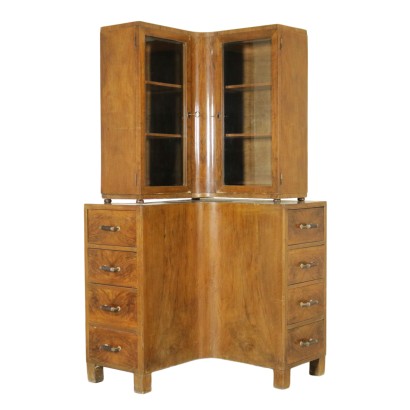Corner Cabinet
Features
Style: Art Deco (1920-1950)
Age: 20th Century / 1901 - 2000
Year: Prima metà '900
Origin: Italy
Main essence: Walnut
Material: Walnut Feather Banded
Description
An Art Decò corner cabinet, eight drawers. The shelf has two small doors with glasses. Manufactured in Italy, first half of the 20th century.
Product Condition:
The item shows signs of wear due to age. Any damage or loss is displayed as completely as possible in the pictures. It may require restoration and buffing.
Dimensions (cm):
Height: 92
Width: 127
Depth: 63
Maximum size (cm):
Height: 183
Additional Information
Style: Art Deco (1920-1950)
The name Art-Decò derives from the exhibition held in Paris in 1925, which was called the International Exhibition of Modern Decorative Arts and was the successor of the Liberty style.Art-Decò is a stylistic historical period formed after the Liberty floral period, shortly after the end of the First World War.
There was an almost radical change anticipated by the growth of the Precisionist movement and that of Cubism (in art), the Art-Decò furnishings were characterized by decidedly more rigid lines and the presence of geometric figures, definitively abandoning the sinuous and moved lines , of objects and furnishings, of the previous Liberty period.
It was established from the dawn of 1915 until the early 30's.
This style was transversal and major exponents were created in the most diverse art forms, from urban architecture to painting, from sculpture to glass masters, from the production of objects as a complement to furnishings to jewelry.
Age: 20th Century / 1901 - 2000
20th Century / 1901 - 2000Main essence: Walnut
Walnut wood comes from the plant whose botanical name is juglans regia , probably originally from the East but very common in Europe. Light or dark brown in color, it is a hard wood with a beautiful grain, widely used in antique furniture. It was the main essence in Italy throughout the Renaissance and later had a good diffusion in Europe, especially in England, until the advent of mahogany. It was used for solid wood furniture and sometimes carvings and inlays, its only big limitation is that it suffers a lot from woodworm. In France it was widely used more than anything else in the provinces. In the second half of the eighteenth century its use decreased significantly because mahogany and other exotic woods were preferred.Material: Walnut Feather Banded
Alternative proposals




























